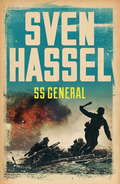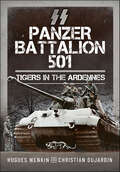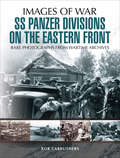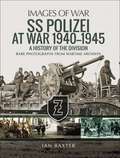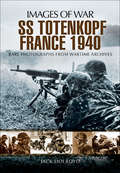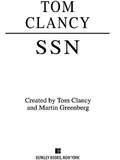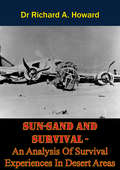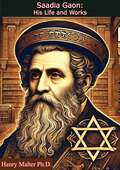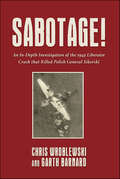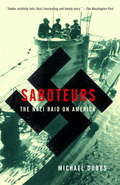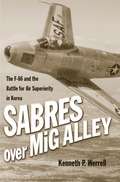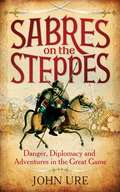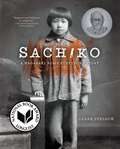- Table View
- List View
SS Foreign Divisions & Volunteers of Lithuania, Latvia and Estonia, 1941–1945: Rare Photographs From Wartime Archives (Images of War)
by Ian BaxterDrawing on a superb collection of rare and unpublished photographs SS Foreign Divisions & Volunteers of Lithuania, Latvia and Estonia 1942 - 1945 describes how the occupying Nazis recruited Lithuanian, Latvian, and Estonian conscripts into the Waffen-SS. Unlike her Latvian neighbor, Lithuania had no plans to provide Germany with a National Legion. Although volunteers came forward, the majority did not. This was not the case for Latvia and Estonia, which undertook huge recruitment programs, and thousands of men were drafted into their own foreign legion of Waffen-SS Grenadier divisions. After intensive training, these divisions saw action on the Eastern front, around Leningrad, in the Ukraine, before vicious defensive operations as the Red Army smashed its way through the Baltic States in 1944. Even in the last dying weeks of the war, what was left of the Baltic soldiers of the 15th, 19th, and 20th Waffen-SS Grenadier Divisions, continued to fight alongside their Wehrmacht and Waffen-SS counterparts until they were either destroyed or surrendered. The story of these divisions is graphically told with detailed captions and text together with many contemporary images in true Images of War style.
SS General
by Sven HasselSS GENERAL is the definitive Stalingrad novel, a gripping portrait of war's brutal realities.It was said that Stalingrad had been burning since August, ever since the first German bombs were dropped...Sven Hassel and his comrades are plunged into the maelstrom of Stalingrad. Radio Moscow reports that one German soldier dies every minute. Trapped by the Russian counter-attack, starving soldiers must resort to cannibalism to survive. But 'Tiny', Porta, the Legionnaire and Sven attempt to break out, to fight their way across the frozen steppe.Their leader: an SS general who takes no prisoners...
SS General (Sven Hassel War Classics)
by Sven HasselSS GENERAL is the definitive Stalingrad novel, a gripping portrait of war's brutal realities.It was said that Stalingrad had been burning since August, ever since the first German bombs were dropped...Sven Hassel and his comrades are plunged into the maelstrom of Stalingrad. Radio Moscow reports that one German soldier dies every minute. Trapped by the Russian counter-attack, starving soldiers must resort to cannibalism to survive. But 'Tiny', Porta, the Legionnaire and Sven attempt to break out, to fight their way across the frozen steppe.Their leader: an SS general who takes no prisoners...
SS Great Britain: Transatlantic Liner, 1843 (Seaforth Historic Ships)
by Wyn Davies Herb SchmitzThe SS Great Britain, designed by Isambard Brunel, was the first ocean-going vessel to be screw-driven and built entirely of iron. When she was launched in 1843 she was twice the size of any previous ship and her revolutionary design heralded a complete break with traditional ship construction. As is the case for many historic ships, however, there is a surprising shortage of informative and well illustrated guides, for reference during a visit or for research by enthusiasts - ship modellers, naval buffs, historians or students. This new series redresses the gap. Written by experts and containing more than 200 specially commissioned photographs, each title takes the reader on a superbly illustrated tour of the ship, from bow to stern and deck by deck. Significant parts of the vessel for example, the propeller, steering gear, engine and accommodation are given detailed coverage both in words and pictures, so that the reader has at hand the most complete visual record and explanation of the ship that exists. In addition, the importance of the ship, both in her own time and now as a museum vessel, is explained, while her design and build, and her career prior to restoration and exhibition are all described.No other books offer such superb visual impact and detailed information as the Seaforth Historic Ship Series a truly groundbreaking concept bringing the ships of our past vividly to life.
SS Panzer Battalion 501: Tigers in the Ardennes
by Hugues Wenkin Christian DujardinThis study, carried out by a duo of Ardennes authors experienced in this episode of the Second World War, examines why the Tiger tank battalion N°501 (schwere SS-Panzer Abteilung 501) was able to survive the Battle of the Bulge. The Peiper Kampfgruppe was the spearhead of the 6th Panzer Army. Most often mentioned for its actions on Ardennes soil, today the Gepanzerte Kampfgruppe "Peiper" remains an object of interest for its actions during the engagements between Stavelot and La Gleize, as well as the engagement of its Tiger II against the American armored units. Although the unit had exceptional crews, including some of the most emblematic aces of the Panzerwaffe, and benefited from the element of surprise, it suffered a bitter failure in the Ardennes. How could a vehicle considered to be among the most powerful of the conflict suffer almost 100 percent losses? In hindsight, can we speak of a tactical failure? This study, carried out by a duo of Ardennes authors experienced in this episode of the Second World War, meets the dual objective of reconstructing the facts and explaining why, in the end, the Tiger tank battalion N°501 (schwere SS-Panzer Abteilung 501) was able to survive the Battle of the Bulge. It includes a summary of their confrontations, a history of the unit, as well as a tank-by-tank analysis of the causes of destruction. In total, the authors found sixteen different examples, and the machines lost one by one in the Ardennes make it possible to follow the unit's course throughout the conflict.
SS Panzer Divisions on the Eastern Front: Rare Photographs From Wartime Archives (Images of War)
by Bob Carruthers“This book is chock full of striking photographs taken throughout the war, from the invasion of Poland, to the last battles in Hungary . . . a treasure.” —Western Slope Division This book follows the path of the 1st SS Panzer Division “Leibstandarte SS Adolf Hitler,” 2nd SS Panzer Division “Das Reich,” 3rd SS Panzer Division “Totenkopf,” and 5th SS Panzer Division “Wiking” from the opening stages of the war and the challenges of Barbarossa, through to the long and bloody retreat to Berlin. This exceptional collection of images captures the titanic struggle endured by these divisions, and the chain of events they set in motion that proved so critical in shaping the face of the Second World War.Featuring rare images, this is the definitive record of SS Panzer Divisions on the Eastern Front, and an essential addition to any enthusiast’s collection.
SS Polizei at War, 1940–1945: A History of the Division (Images of War)
by Ian BaxterFormed in 1939 SS-Polizei Division were not considered initially as an SS fighting force, and this status was reflected in the quality of the equipment they were issued. Following operations in France, Greece and then Russia, it was not until 1942 the division was transferred to the Waffen-SS, and eventually upgraded to a Panzergrenadier division, the 4th SS-Polizei-Panzergrenadier Division.The book describes how the SS-Polizei Division fought across the Low Countries, the Eastern Front, before deploying to the Balkans and Greece where it committed numerous atrocities. During the last days of the War it was assigned to Army Detachment Steiner defending Berlin where many soldiers fought to the death.This book is a unique glimpse into one of the most infamous fighting machines in World War Two and a great addition to any reader interested Waffen-SS history.
SS Specialist Units in Combat (Images of War)
by Bob CarruthersIt is an often overlooked fact that the SS Divisions included Cavalrymen, Paratroopers, Mountain and Ski Battalions and these rare photographs illustrate the unique role played by specialist units in action.
SS Totenkopf France, 1940 (Images of War)
by Jack Holroyd"By the end of the Second World War the reputation of Hitler's Schutzstaffel (SS) had become so heavily sullied that the organization was branded criminal and banned in postwar Germany. It's authority in Nazi Germany had been enormous having been made responsible for Reich internal security, it implemented Nazi racial policy and managed the death camps. Most oddly it produced a rival military organization to the German regular army fighting alongside it but never a part of it the Waffen SS. SS-Totenkopf is a photographic account of that unit's birth and first month of active service. The Division, formed from concentration camp guards, fought alongside Rommel's 7th Panzer Division against the only British armored counterattack of the campaign. However, instances of atrocities committed by men of the Totenkopf began early and the machine-gunning of 97 prisoners of the Norfolk Regiment occurred. In this brief and violent history of the birth of an SS division the original captions and text which accompanied the photographs have been retained in order to capture the original flavor. The translated text appears inter spaced with the author's explanations. The SS War Correspondent photographers risked their lives to take some of these pictures so up-with-the-action they were and, with their 'blood up', their comments are nationalistically passionate. This is understandable, so successful was the Blitzkrieg campaign in 1940 compared to the efforts of their fathers in 1914–1918 when they failed to break through to the Channel coast. It helps us to understand the euphoric reaction of some of the Totenkopf at the sight of the English Channel. "
SS Totenkopf at War: A History of the Division (Images of War)
by Ian BaxterThe SS Totenkopf (Death Head) Division even 70 years on retains its formidable and ruthless reputation as a superbly efficient yet murderous formation. It earned this for its actions throughout the Second World War, first in 1940 during the blitzkrieg in Northern France and then on the Eastern Front. The battles at Kharkov and Kurst saw some of the fiercest fighting of that long and terrible campaign. During the long retreat back to the Fatherland the Division fought with customary dogged determination, nay fanaticism. This superbly illustrated work, drawing on images taken by participants, portrays the SS Totenkopfs history from formation through training to the battles in northern France and in Russia.
SSN: A Strategy Guide to Submarine Warfare
by Tom ClancyThe "forgotten Clancy novel," SSN is a complete submarine warfare novel with maps, photos, and a special interview with Tom Clancy and former submarine commander Doug Littlejohns.<P> China has invaded the oil-rich Spratly Islands. The American response has been swift and deadly, resulting in the start of World War III. SSN: Strategies of Submarine Warfare presents 15 thrilling scenarios--fact-based mission profiles for Captain Bartholomew Mackenzie and the crew of the nuclear submarine the U.S.S. Cheyenne--stirring plots and characters, perfectly accurate details, and the chilling knowledge that these events could really happen.
STORY OF THE CAMPAIGN OF SEBASTOPOL: Written In The Camp [Illustrated Edition]
by Lieutenant-General Sir Edward Bruce Hamley KCB KCMG[Illustrated with over two hundred and sixty maps, photos and portraits, of the battles, individuals and places involved in the Crimean War]"Eyewitness account of the fighting during the Crimean War."While I was delivering the order, a round shot passed through my horse, close to the saddle, and rolled us over; while on the ground another canon shot passed through him. A sergeant of artillery ran to extricate me; he had just lifted from under the horse, and I was in the act of steadying myself on his shoulder, when a shot carried off his thigh and he fell back on me....This is a scene describes a narrow escape for Hamley during the bloody battle of Inkerman. The author of this remarkable book, a Gunner officer, served on the Artillery Staff, first as Adjutant to the First Division field artillery and then as ADC to the Commander Royal Artillery throughout the siege of Sevastopol, and as such he was well placed to make this record of the campaign. As he says in the introduction it was not his intention to indulge in fanciful rhetoric but to give a 'round, unvarnished tale.' All was written in camp when he was off duty, in a tent or in a hut, and his descriptions of the fighting and the aftermath paint a grim and often gruesome picture. Disease and sickness ravaged the army; in Dec. 1854 and Jan. 1855 the sick returns amounted to 14,000. The pictures he paints, in his matter-of-fact narrative, reflect some appalling sights of the dead and dying on the battlefields. He takes us through the Alma, Inkerman, Balaklava to the fall of Sevastopol in Sep. 1855 which was the prelude to the peace talks a few months later. The siege of Sevastopol lasted a year and cost the British some 11,000 casualties, the French 12,000 and the Russians 50,000. There are some very good illustrations by the author himself. For the students of this dreadfully mishandled war (administration, logistics and medical) this book will be compulsive reading."-Print Ed.
SUN-SAND AND SURVIVAL - An Analysis Of Survival Experiences In Desert Areas
by Dr Richard A. HowardDesert survival presents unique problems not met in other non-temperate areas. Recognizing this, the Arctic, Desert, Tropic Information Center commissioned Dr. Richard A. Howard to assemble and analyze desert survival experiences of World War II, for the purpose of increasing our knowledge of desert survival techniques and procedures. To know what World War II survivors did, what they thought, and what they recommended after having experienced desert survival conditions is of paramount importance. Sun, Sand and Survival relates and evaluates these experiences.Dr. Howard, ADTIC consultant, has had long experience in the survival training of military personnel. He is the author of the ADTIC Publication T-100 999 Survived which analyzes 1,000 tropical survival experiences. Dr. Howard's desert study analyzes 382 successful desert survival episodes and mention is made of an additional 142 individuals who were lost. The stories show how men without desert background or mental conditioning met their desert problems. They include examples of men who left their group and were never heard of again. In the light of our present knowledge of the water requirements of the human body, we know that many could have survived had they had a better understanding of the requirements imposed by the desert. More survivors would have returned in better health and endured less discomfort if advance knowledge had been readily available.
Saadia Gaon: His Life and Works
by Henry MalterUncover the remarkable legacy of one of Judaism's most influential figures with Henry Malter's comprehensive biography, "Saadia Gaon: His Life and Works." This meticulously researched book offers an in-depth look at the life, philosophy, and enduring contributions of Saadia Gaon, a towering intellect of the medieval Jewish world.Henry Malter, a distinguished scholar of Jewish history and literature, delves into the multifaceted achievements of Saadia Gaon, who lived during the 9th and 10th centuries. Known for his exceptional scholarship, Saadia was a philosopher, exegete, and community leader whose work laid the foundations for much of Jewish thought and practice."Saadia Gaon: His Life and Works" explores Saadia's early years in Egypt, his rise to prominence as the head of the Sura Academy in Babylon, and his prolific contributions to Jewish scholarship. Malter provides a detailed account of Saadia's major works, including his influential translation and commentary on the Hebrew Bible, his philosophical treatise "The Book of Beliefs and Opinions," and his writings on Hebrew grammar and poetry.Through rich historical context and insightful analysis, Malter highlights Saadia's role in defending Rabbinic Judaism against the Karaites, a Jewish sect that rejected the Oral Torah. Saadia's rational approach to faith, his commitment to integrating Jewish tradition with contemporary philosophy, and his efforts to make Jewish texts accessible to a broader audience are all examined in depth.This biography also sheds light on Saadia's personal struggles and his unwavering dedication to his community. Malter's portrayal of Saadia Gaon is both scholarly and accessible, making complex theological and philosophical concepts understandable to a wide readership."Saadia Gaon: His Life and Works" is an essential read for students of Jewish history, theology, and philosophy. Henry Malter's authoritative and engaging narrative ensures that the legacy of Saadia Gaon is both preserved and appreciated, offering readers a profound understanding of his enduring impact on Jewish thought.
Saarbrück to Paris, 1870: A Strategical Sketch (Special Campaigns Series #1)
by Lt. Colonel Sisson C. PrattThe Franco-War of 1870 marked an absolute watershed: France had been the military and cultural centre-point of mainland Europe for some centuries, its fashion copied, its armies feared and its language the language of diplomacy and the highest circles. Growing in power, prestige and ambition, the states of Germany stood in opposition to this hegemony, a newborn power with much to prove. Its dominant driving force was Prussia, under the determined statesman Bismarck. The French goaded the Germans into action, provoking war. The Germans had been preparing for the conflict for some years and sprung into action, and the ensuing action would be a debacle for the French and a might victory for the Germans.This book is part of the Special Campaigns series produced around the turn of the 20th century by serving or recently retired British and Indian Army officers. They were intended principally for use by British officers seeking a wider knowledge of military history.Author -- Lt.-Colonel Sisson C. Pratt (Late R.E.) (1844-1919)Text taken, whole and complete, from the edition published in 1907, London and New York, by Swan Sonneshein & Co. Ltd.Original Page Count - vii and 209 pages.Illustrations - The original maps cannot be provided with this edition due to their A3 size.
Sabotage in the Sky
by L. Ron HubbardLaunch into the action with this triumphant tale! Pilot Terry Lee has taught Bill Trevillian everything he knows about flying, enough that Bill's know considered the ace of American test pilots just as war breaks out in World War II Europe. Unknown to Bill, Terry's also taught his own kid sister, Kip, who's now almost as good a pilot as Bill and quite the looker to boot. When France and Great Britain must choose between different American plane designs to outfly the newest and deadliest Nazi fighters, the competing companies send their two best test pilots . . . Kip and Bill. Unfortunately, a spy also has been sent to infiltrate and sabotage the planes to make sure that neither the French nor British will consider them safe enough to fly. Soon Kip and Bill suspect the other of sabotage-- a problem that not only threatens their already electric relationship but their very lives. "Riveting cliff-hanger action." --Midwest Book Review
Sabotage!: An In-Depth Investigation of the 1943 Liberator Crash that Killed Polish General Sikorsky
by Chris Wroblewski Garth BarnardOn the night of 4 July 1943, transport aircraft Liberator AL523 took off from Gibraltar’s North Front tarmac and within moments crashed into the sea with only one survivor, the pilot. The commander-in-chief of the Polish army and prime minister of the Polish government-in-exile, General Władysław Sikorski, was dead. Rumours as to the cause of the crash abounded. Was it pilot error? Was it, as officially classified, merely an accident, or was it, as the authors conclude in this riveting and meticulous study, an act of sabotage? In this extensive piece of research, Chris Wroblewski and Garth Barnard examine numerous primary sources, including the complete court of inquiry transcripts, produce detailed analysis of aircraft components and systems and unearth many little-known eyewitness accounts to give this investigation a compelling conclusion. Within the book the authors also dispel several conspiracy theories that have emerged since this catastrophe; particularly that this event was a disastrous assassination attempt with blame on the British, Soviets and Nazis. This is an exhaustive piece of investigative journalism that puts the record straight once and for all.
Saboteurs: The Nazi Raid on America
by Michael DobbsShortly after America's entry into World War II, Adolf Hitler ordered an extensive sabotage campaign against the United States to disrupt the production of tanks and airplanes and blow up bridges and railroads. Eight German saboteurs were dispatched across the Atlantic by U-boat, one team landing in Amagansett, Long Island, the other near Jacksonville, Florida. They brought with them enough money and explosives for a two-year operation and traveled inland to explore potential targets. The full story of this audacious endeavor is a remarkable account of a terrorist threat against America. Michael Dobbs describes the saboteurs' training in Nazi Germany, their claustrophobic three-week voyage in submarines, and their infiltration into American life. He explores the reasons each volunteered, and their links to a network of Nazi sympathizers in the United States. He paints a portrait of the group's leaders:George Dasch, a onetime waiter who dreamed of leaving his personal mark on history, and Edward Kerling, a fanatic Nazi caught between his love for his mistress and his love for his wife. And he shows how the FBI might never have captured the saboteurs had one of them not helped J. Edgar Hoover transform a hapless manhunt into one of his proudest accomplishments. A military tribunal, a historic Supreme Court session, and one of the largest mass executions in American history provide a stunning climax to a dangerous but failed mission.
Sabre Rattling in Space: A South Asian Perspective
by Ahmad Khan Eligar SadehThis book offers historical and theoretical context of the path followed by States, from space militarization to weaponization, and deconstructs traditional security paradigm myths to prove that a paradigm shift has been brought because of deadly space weapons developed by major space powers. It reconciles that the strategic distrust between two leading space competitors, U.S. and China, has prompted them to pursue counter-space capabilities. The ripple effect of this troubling relation in space is not limited at the global level, but has witnessed a trickledown effect on regional security. In relation to this, the book offers details of the Indian space program including its military space ambitions, and provides information about Pakistan’s objectives in space. It offers an overview of challenges to international space governance and how the structural flaws help states to aggressively follow a path toward space weaponization. Additionally, it discusses the UN negotiating arms control measures in space and the politics of states not to negotiate prevention of an arms race in outer space. The book is a useful contribution to space security, from both traditional and contemporary approaches, covering history, theory, and application. It provides an academic as well as practical approach carrying appeal for professionals, experts, opinion makers, industry, academics, teachers, policy makers, politicians and masses from other walks of life who are interests in space security.
Sabre Squadron
by Cameron SpenceWith the outbreak of Gulf War hostilities a unit from 22 SAS slipped quietly over the border and into the enemy's backyard. It would be six weeks before any of the patrol again reached safety.Sabre Squadron recounts in graphic detail their scud-busting operations deep inside Iraq. They were operating alone and out of reach of reinforcements, with the threat of detection and its fatal consequences ever present. Yet their determination to wreak havoc behind enemy lines remained undimmed, culminating in an attack that decisively reconfirmed the regiment's awesome reputation.Cameron Spence, a senior NCO on the operation, takes you as close to the fighting SAS as you are ever likely to get, conveying the relentless tension, black humour and camaraderie punctuated by explosive, nerve-shredding action that characterized the mission.This is the true story of an SAS operation of breathtaking audacity and flair, carried out under unimaginable pressure, in the face of impossible odds._____________'A brilliantly authentic account of war with an SAS patrol, it's a fantastic read' - ANDY MCNAB, bestselling author of Bravo Two Zero'Tense and at times terrifying... a well told action story' - SUNDAY TELEGRAPH'A terrific read' - THE TIMES'Blood, guts and military macho - as authentic as anything you are likely to read' - MAIL ON SUNDAY
Sabres Over MiG Alley
by Kenneth P. WerrellThis is the story of the first jet versus jet war, the largest in number of victories and losses, and one of the few military bright spots in the Korean War. It tells how an outnumbered force of F-86 Sabres limited by range and restricted by the rules of engagement, decisively defeated its foe. Based on the latest scholarship, author Kenneth Werrell uses previously untapped sources and interviews with sixty former F-86 pilots to explore new aspects of the subject and shed light on controversies previously neglected. For example, he found much greater violation of the Yalu River than thus far has appeared in the published materials. The F-86 became a legend in "The Forgotten War" because of its performance and beauty, but most of all, because of its record in combat.
Sabres on the Steppes: Danger, Diplomacy and Adventure in the Great Game
by Sir John UreBack in the day when men were men and Britain ruled the world, the two great world powers went head to head over control of central Asia - from the Caucasus to Kabul. This was the stage of open warfare but also espionage, subterfuge and reckless adventure. Following on from the derring do of Shooting Leave, John Ure tells the story of British soldiers, missionaries and mercenaries, horse traders and opportunists who travelled to make their name in the Great Game.Praise for Shooting Leave:'Extremely entertaining ... deserves to be a surprise Christmas bestseller.' Robert Harris.'Gripping stuff.' Peter Hopkirk.'Anyone with red blood in his or her veins will be stirred by these stories ... The perfect read.' Country Life.
Sabres on the Steppes: Danger, Diplomacy and Adventures in the Great Game
by John UreBack in the day when men were men and Britain ruled the world, the two great world powers went head to head over control of central Asia - from the Caucasus to Kabul. This was the stage of open warfare but also espionage, subterfuge and reckless adventure. Following on from the derring do of Shooting Leave, John Ure tells the story of British soldiers, missionaries and mercenaries, horse traders and opportunists who travelled to make their name in the Great Game.
Sachiko: A Novel (Weatherhead Books on Asia)
by Shūsaku EndōIn novels such as Silence, Endō Shūsaku examined the persecution of Japanese Christians in different historical eras. Sachiko, set in Nagasaki in the painful years between 1930 and 1945, is the story of two young people trying to find love during yet another period in which Japanese Christians were accused of disloyalty to their country.In the 1930s, two young Japanese Christians, Sachiko and Shūhei, are free to play with American children in their neighborhood. But life becomes increasingly difficult for them and other Christians after Japan launches wars of aggression. Meanwhile, a Polish Franciscan priest and former missionary in Nagasaki, Father Maximillian Kolbe, is arrested after returning to his homeland. Endō alternates scenes between Nagasaki—where the growing love between Sachiko and Shūhei is imperiled by mounting persecution—and Auschwitz, where the priest has been sent. Shūhei’s dilemma deepens when he faces conscription into the Japanese military, conflicting with the Christian belief that killing is a sin. With the A-bomb attack on Nagasaki looming in the distance, Endō depicts ordinary people trying to live lives of faith in a wartime situation that renders daily life increasingly unbearable. Endō’s compassion for his characters, reflecting their struggles to find and share love for others, makes Sachiko one of his most moving novels.

